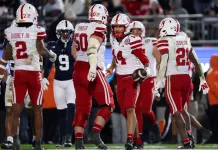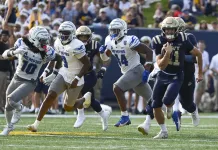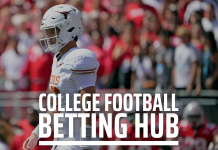College Football Home-Field Advantage
Key Takeaways:
- College football home-field advantage greatly varies
- 69 of 136 college football teams have more or less than standard home-field advantage
- Consider game time and opponent in your calculation
I opened my college football home-field advantage article in last year’s College Football Betting Guide by acknowledging that neither you nor I know what it is actually worth. There are so many variables that can raise or lower the value of playing in front of hundreds, thousands, tens of thousands, or more than one hundred thousand fans.
Rivalry games seem to make it matter just a little more or those big matchups under the lights. Wouldn’t an ESPN game on a Tuesday night for the Sun Belt factor HFA in more than a random Saturday game against a FCS opponent? Wouldn’t Penn State fans treat a White-Out differently than a sleepy Noon kickoff in September against a MAC school? HFA throughout the year can also vary if a team is really overperforming relative to expectations and the students are showing out or if a team stinks and the students have better things to do.
Sometimes you have a basketball school, where students are really engaged until November, when they’d rather spend their Saturdays pregaming for an indoor event. Weather can impact crowds. Holidays. School breaks. Market size. All sorts of things.
In other words, painting with a broad brush is really simplistic.
That being said, we have to have some value in mind for home-field advantage, right? Having a baseline and manipulating it from that point for the situation, matchup, weather, or any other factor is a good start. Last season, I went from analyzing a five-year sample of home performance to analyzing a three-year sample. COVID was one of the reasons behind my rationale, something that would still impact a five-year sample.
The larger reason is that college football teams look dramatically different from year to year. At larger programs, a group of guys together for three seasons is possible. At smaller schools, it is highly unlikely. Nevertheless, some measure of sample size feels like a requirement, so I kept it at three seasons.
Your view may vary and your standard HFA may very well be more than two points. Some people I respect still use 3. Others are down to 1.5 or 1, or even zero, depending on the team and how they’ve performed at home.
For me, teams are placed into “buckets” and ones that meet certain thresholds either go above or below the standard-issue two points. For this season, there are 19 teams with my max HFA of 3.5 points, 18 teams with 3 points, 16 teams with 2.5 points, seven teams with 1.5 points, and nine teams with 1 point. That means more than half (69) of the FBS teams (136) qualify one way or another.
The home records are courtesy of Steve Makinen and his extensive database, so my thanks go out to our VSiN Analytics Guru.
Here are those teams for the 2025 season:
3.5 Points (SU + ATS Home Win% of 70% or Higher)
- Alabama
- Boise State
- Duke
- Georgia Southern
- Jacksonville State
- Kansas State
- Louisville
- LSU
- Missouri
- Ohio
- Ohio State
- Oregon
- Oregon State
- Penn State
- SMU
- Tennessee
- Texas
- UTSA
- Washington
3 Points (65-69.99%)
- Delaware
- Georgia
- Iowa
- James Madison
- Liberty
- Marshall
- Michigan
- Mississippi
- Notre Dame
- Oklahoma
- Rice
- TCU
- Texas Tech
- Toledo
- Troy
- USC
- Utah
- Washington State
2.5 Points (60-64.99%)
- Army
- Ball State
- Connecticut
- Clemson
- Indiana
- Kansas
- Memphis
- Miami (OH)
- New Mexico State
- San Jose State
- South Carolina
- Syracuse
- Tulane
- UAB
- UNLV
- Western Kentucky
*Note: Any team between 40-59.99% has a standard HFA of 2 points.*
1.5 Points (35.01-39.99%)
- Cincinnati
- Kennesaw State
- Northwestern
- Old Dominion
- Sam Houston State
- South Florida
- Vanderbilt
1 Point (35% or Lower)
- Charlotte
- Georgia State
- Kent State
- Massachusetts
- Nevada
- Northern Illinois
- Purdue
- Stanford
- Tulsa
There were several surprises on this list for me, both in terms of who is on the list and who is not (hi, Akron!). These home-field advantage values work in tandem with my Power Ratings to help me put together a line early in the week to see if I can find some betting value on opening numbers or what the market has on Monday or Tuesday.
If I’m doing a good job, the market should move towards my line more often than not, but I also have to keep in mind that my HFA system may not be similar at all to what sportsbooks and market influencers have. This is just my process, plus I have to handicap the qualitative factors mentioned above, like the magnitude of the game and other elements.
Back in the VSiN 2022 College Football Betting Guide, I called home-field advantage an “inexact science” and continue to use that expression because my feelings on it remain the same. But, if I have a process that is backed by something, I feel very confident in the “something is better than nothing” camp when it comes to such a difficult thing to pin down.






